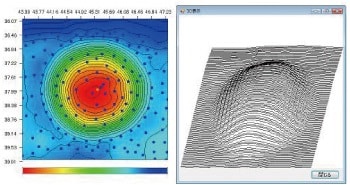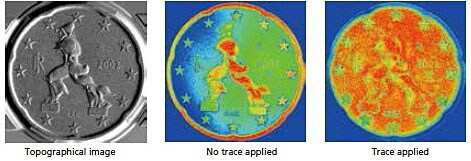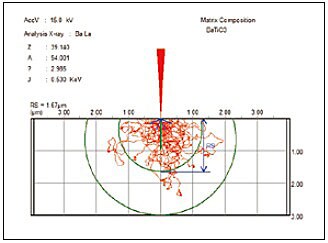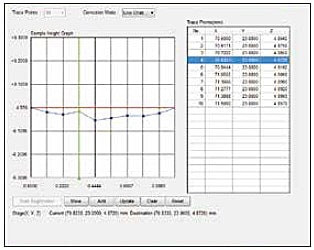EPMA-8050G - Opciones
Electron Probe Microanalyzer
Trace Mapping Analysis

Trace functions can be added to standard mapping analysis. For samples with surface irregularities or inclination, when the height changes as a function of the X-Y position, the sample's Z axis height can be corrected, enabling high-accuracy mapping analysis in which reductions in signal intensity are minimized.
This feature is achieved by minutely controlling the stage's Z axis coordinates during the analysis, based on height data obtained beforehand from multiple points. The trace surface found from the configured height data can be confirmed via contour lines and 3D displays.

Illustration of the Basic Principle
Mapping Analysis Results
Example of a sample 20 cent coin: Cu mapping

A more correct elemental distribution is obtained by using the trace.
* The trace is centered on the figure and periphery. The stars and the border are not targeted.
Phase Analysis Program
A scatter diagram is created with the 2D or 3D correlations obtained from mapping data for each element. Regions featuring a particular relationship between elements are displayed in different colors.
In addition, multiple scatter diagrams can be displayed simultaneously, enabling the observation of correlations between multiple elements.

Features
By creating a 3D image of the scatter diagrams, it is possible to observe the correlation from a variety of observation points.

Multiple correlations can be analyzed while switching between elements and scatter diagrams.

Electron Beam Penetration Domain

It is possible to simulate the analysis depth and width of the irradiating electron beam penetrated from the surface of the sample. The Primary X-ray emission volume can be calculated by using either the electron range method, with which the electron beam diffusion size and the analysis domain are found, or the Monte Carlo method, which follows individual electron trajectories to obtain the total electron trajectory (penetration domain).



